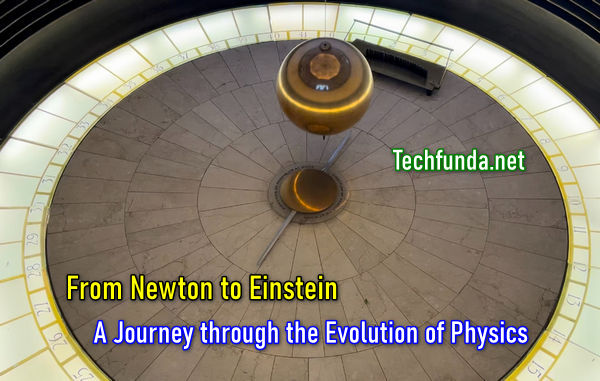Introduction to the History of Physics
Come on a journey through the vast world of scientific exploration as we explore the evolution of physics. From ancient times to modern breakthroughs, this captivating field has revolutionized our understanding of the universe and pushed the limits of human knowledge. Prepare to be awed by some of history’s most brilliant minds as we dive into their groundbreaking contributions – from Sir Isaac Newton’s laws governing motion to Albert Einstein’s mind-bending theory of relativity. Let’s delve into how these innovative ideas have shaped our world and continue to inspire scientists today. So buckle up (or perhaps we should say, brace yourself for electromagnetic forces?), because this ride is sure to be an exhilarating one!
The Contributions of Sir Isaac Newton
Sir Isaac Newton, a name that resonates through the annals of scientific history. Born in 1643, this English mathematician and physicist made groundbreaking contributions to the field of physics that forever changed our understanding of the universe.
One of Newton’s most famous accomplishments was his formulation of the laws of motion. These three laws describe how objects move in response to external forces and provided a solid foundation for classical mechanics. They are still widely used today in everything from engineering to space exploration!
Another significant contribution by Newton was his theory of universal gravitation. By observing falling apples and studying celestial bodies, he proposed that every object in the universe attracts every other object with a force proportional to their masses and inversely proportional to the square of their distance apart. This revolutionary idea laid the groundwork for understanding planetary motion, tides, and even satellite orbits!
Newton also delved into optics, conducting experiments with light and discovering that it consists of different colors combined together. He developed mathematical equations describing how light behaves when passing through different mediums or encountering obstacles—a field known as optics.
Newton’s contributions extended beyond theoretical physics; he also invented calculus! Calculus is an essential branch within mathematics that has applications not only in physics but also in various fields like economics, engineering, biology, and computer science.
Despite his immense contributions to science, Newton faced controversy during his lifetime due to conflicts with other scientists such as Robert Hooke and Gottfried Leibniz over credit for developing calculus.
In summary (without using “In conclusion” or “Overall”), Sir Isaac Newton’s work revolutionized our understanding of motion, gravity, optics, and mathematics itself. His ideas remain foundational principles taught worldwide today!

Albert Einstein and the Theory of Relativity
One name that is synonymous with genius in the field of physics is Albert Einstein. His groundbreaking theory, known as the Theory of Relativity, revolutionized our understanding of space, time, and gravity.
Einstein’s journey into physics began during his early years at university when he became fascinated by the works of Isaac Newton. However, it was his own unique insights and thought experiments that led him to develop a whole new framework for understanding the world around us.
The Theory of Relativity can be divided into two parts: special relativity and general relativity. Special relativity deals with objects moving at high speeds, while general relativity considers gravity’s effects on space-time.
One key concept introduced by Einstein was that nothing can travel faster than light. This notion had profound implications for our understanding of causality and challenged long-held beliefs about absolute time.
General relativity expanded upon these ideas by explaining how mass warps space-time itself. It provided a new perspective on gravity as not just a force but rather as a curvature in the fabric of spacetime caused by massive objects.
Einstein’s theories were confirmed through various experiments over the years, including measurements during solar eclipses that demonstrated light bending due to gravitational influence.
The impact of Einstein’s work cannot be overstated. Not only did it transform our understanding of physics but also influenced fields such as cosmology and astrophysics. The development of technology like GPS systems relies heavily on incorporating relativistic corrections due to differences in gravitational fields between satellites orbiting Earth.
Albert Einstein’s contributions continue to shape modern physics and inspire future generations of scientists. His brilliance lies not only in his mathematical equations but also in his ability to think outside conventional boundaries – challenging established notions and pushing humanity further along its never-ending quest for knowledge.

Modern Physics and Quantum Mechanics
Modern Physics and Quantum Mechanics have revolutionized our understanding of the universe, taking us beyond Newtonian laws to a realm of mind-bending concepts and phenomena. This branch of physics explores the behavior of particles at the smallest scales, challenging our intuitions about reality.
In quantum mechanics, particles exist in states called superposition, where they can be in multiple places or states simultaneously. This concept was famously explained by Schrödinger’s cat thought experiment – a theoretical cat that is both alive and dead until observed. The uncertainty principle, proposed by Heisenberg, tells us that we cannot precisely measure both the position and momentum of a particle simultaneously.
Quantum mechanics also introduced the idea of entanglement, where two particles become connected in such a way that their states are linked regardless of distance. It’s as if they communicate instantaneously with each other – an effect Einstein referred to as “spooky action at a distance.”
These discoveries have led to groundbreaking technologies like quantum computing and encryption. Quantum computers harness these strange properties to perform calculations exponentially faster than traditional computers. Quantum encryption ensures secure communication by encoding information using entangled particles.
The study of modern physics challenges our notions of determinism and pushes the boundaries of what we consider possible. It forces us to grapple with concepts like wave-particle duality and non-locality, reminding us that nature operates in ways far more mysterious than we could ever imagine.
As scientists continue unraveling the mysteries within this field, new insights into fundamental aspects not only shape our scientific understanding but also hold potential for transformative innovations in various industries from medicine to energy production.
Modern physics keeps pushing forward on its never-ending quest for knowledge – constantly revealing how little we truly know about the universe around us!
The Impact of Physics on Society
Physics, the study of matter and energy, has had a profound impact on society throughout history. From technological advancements to our understanding of the universe, physics has shaped the way we live and perceive the world around us.
One major area where physics has made significant contributions is in technology. The development of electricity and electromagnetism in the 19th century revolutionized communication and transportation. It led to inventions such as telegraphs, electric motors, light bulbs, and eventually paved the way for modern electronics.
Physics also plays a crucial role in healthcare. Medical imaging technologies like X-rays, CT scans, and MRI machines are all based on principles of physics. These diagnostic tools allow doctors to visualize internal structures non-invasively, helping with early detection and accurate diagnosis.
Another aspect where physics leaves its mark is energy production. Understanding thermodynamics enabled us to harness various sources of energy like fossil fuels or renewable resources such as solar power or wind turbines. This knowledge allows us to generate electricity efficiently while minimizing environmental impacts.
In addition to these practical applications, studying physics expands our horizons by unraveling the mysteries of the universe itself. Concepts like relativity theory or quantum mechanics challenge our perceptions of space-time and reality at its core.
Let’s not forget about one more indispensable contribution – education! Physics education equips individuals with critical thinking skills necessary for problem-solving across different fields – from engineering to finance.
Controversies in the World of Physics
The world of physics, with its mind-boggling theories and groundbreaking discoveries, is not immune to controversies. In fact, it is often these controversies that push the boundaries of our understanding and pave the way for new insights.
One such controversy revolves around the nature of light. For centuries, scientists debated whether light behaved as a wave or a particle. This debate reached its peak in the early 20th century when physicists like Albert Einstein proposed that light could exhibit both wave-like and particle-like properties – a concept known as wave-particle duality.
Another hotly contested issue is the existence of parallel universes. Some physicists argue that there may be an infinite number of universes coexisting with our own, each with its own set of physical laws and constants. While this idea may seem far-fetched to some, others believe it offers a potential explanation for certain phenomena that cannot be explained within our current understanding.
Quantum mechanics also presents its fair share of controversies. One example is Schrödinger’s cat paradox – a thought experiment where a cat can exist simultaneously in two states until observed. This paradox challenges our intuitive notion of reality and raises questions about how we perceive and interact with quantum systems.
Furthermore, there are ongoing debates about fundamental particles and their interactions. Scientists continue to search for evidence supporting various theories beyond the standard model, such as supersymmetry or string theory. These theoretical frameworks aim to unify all four fundamental forces (gravity, electromagnetism, weak nuclear force, strong nuclear force) into one cohesive theory but have yet to receive experimental confirmation.
However contentious these topics may be among scientists themselves; they demonstrate the dynamic nature of physics as an evolving field shaped by constant inquiry and open-mindedness.

Applications in Everyday Life
Physics is not just an abstract science that exists solely within the confines of laboratories and academic textbooks. It permeates every aspect of our daily lives, even if we are not always aware of it.
One area where physics has a significant impact is technology. From the smartphones we use to communicate and navigate our world, to the medical equipment that saves lives, physics plays a crucial role in their development and functioning.
Consider electricity, for example. Without an understanding of electrical currents and circuits, we wouldn’t have light bulbs illuminating our homes or power outlets charging our devices. Physics allows us to harness this energy efficiently and safely.
Furthermore, physics provides the foundation for modern transportation systems. The principles of motion and mechanics enable engineers to design cars with optimal fuel efficiency and safety features that protect drivers on the road.
Another everyday application can be found in household appliances like refrigerators and air conditioners. These rely on thermodynamics – a branch of physics – to regulate temperature by transferring heat from one place to another.
In sports, too, physics comes into play. From calculating projectile motion in baseball pitches to optimizing aerodynamics in racing cars or bicycles, athletes benefit from understanding these principles to enhance their performance.
Even something as simple as cooking involves concepts from thermodynamics – knowing how heat transfers during different stages of cooking helps chefs create delicious meals consistently.
These examples merely scratch the surface of how physics impacts our daily lives. Whether it’s through advanced technologies or fundamental concepts applied on a smaller scale, the evolution of physics continues to shape our world for the better.
Conclusion
As we have journeyed through the evolution of physics, from the groundbreaking discoveries of Sir Isaac Newton to the revolutionary theories of Albert Einstein and beyond, one thing becomes abundantly clear – our quest for knowledge knows no bounds.
Physics has shaped our understanding of the world around us and continues to push the boundaries of human comprehension. It has given us a deeper insight into the fundamental laws governing nature and opened up new possibilities for technological advancements that were once unimaginable.
But even as we celebrate these achievements, it is important to remember that there is still much we don’t know. The universe holds countless mysteries yet to be unraveled, waiting for curious minds to embark on new journeys of discovery.
In this never-ending quest, physicists continue to challenge existing theories and explore uncharted territories. They seek answers to questions about dark matter and dark energy, delve into the mysteries of quantum entanglement and black holes, and strive to uncover the underlying unity behind all physical phenomena.
But physics is not limited solely to academic pursuit. Its impact permeates every aspect of our lives. From medical imaging technologies like MRI scanners and PET scans that help in diagnosing diseases, to GPS systems that guide us accurately from point A to point B – all are rooted in principles founded by physicists.
Furthermore, controversies within physics drive innovation and progress forward. Debates surrounding topics like string theory or interpretations of quantum mechanics foster deep discussions that often lead scientists down unexpected paths towards breakthroughs.
In conclusion (without actually saying “in conclusion”!), exploring the evolution of physics reveals an ongoing story filled with remarkable discoveries, brilliant minds pushing boundaries, controversies sparking debate, impactful applications in everyday life – all fueled by an insatiable hunger for knowledge.
So let us marvel at how far we’ve come while eagerly anticipating what lies ahead on this endless journey through time and space – always in awe of how physics continuously evolves before our very eyes.
